The main reason why CTE is COMPLETE BULLSHIT (and, I’m sure, made up as somebody’s joke to show how dumb people are), is that there’s no discussion in it whatsoever about the PRECISION needed to pocket balls.
A recent thread has opened more discussion about it, and one post pointed further to a discussion about the error range in shot-making
I was surprised to see in that last post the claim that a fine cut shot could have an error range of only about a TENTH OF A MILLIMETER! Personally, I’m a little reluctant to just take people’s word for such things—and I had always intended to someday have a look at just this issue myself—so I thought I would figure out this information myself and see what it looked like. Below is the data I worked out. FIRST, please note, the info below says NOTHING about the need to adjust for throw or English—but those issues change only the aiming POINT, not the error range in aiming and making a shot.
To figure out how to calculate these I drew the diagram below, and quickly realized it was simple: I only needed to calculate the distance of point “a” from the origin—for balls of 2.25 inches in diameter.
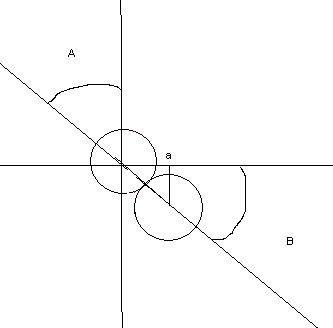
The first bit of info is from Excel. The columns are:
1) The angle (in degrees) off the straight line down which the CB is shot. So, for example, a “1” is one degree off from a straight-in shot. An “89” is the finest cut shot.
2) Distance of CB edge (at equator) from OB edge (at equator). For example, to shoot the OB 1 degree to the left (from the straight line path of the CB), align the CB so that it’s left edge is 0.039 inches to the right of the OB edge. (Note: There is some rounding error in the figures, to make them easier to look at).
3) This difference between the measurement for this angle, and the preceding angle. This figure shows the difference in aim needed to change ONE DEGREE of angle, AT the angle being shot at. Note that this changes depending on the thickness of the cut.
4) Just for fun, I noted in this column how many “64ths of the OB” the aim point (col 2) would be at. If you’re going to use an edge aiming system, obviously you can’t estimate to aim “1.354 inches” from the OB edge. You have to have some method for estimating. It seems to me that the only reasonable way would be to divide the OB into fractions, and to aim at a certain fraction. The FINEST possible fraction system I could imagine would be practical would be into 64ths of the OB—making each fraction about 1/28th of an inch (2.25"/64).
If you want to try these calculations yourself, here are the Excel formulas for each column:
2 (aim): “=2.25*COS(RADIANS(90-RC[-1]))”
3 (Diff): “=RC[-1]-R[-1]C[-1]”
4 (sixty-fourths): “=ROUND(RC[-2]/(2.25/64),0)”
The main thing to note about these columns is toward the bottom of the last column: As cuts get thinner and thinner, more “1 degree angles” are included in each 64th fraction of the object ball.
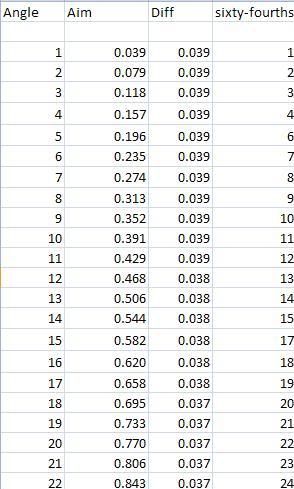
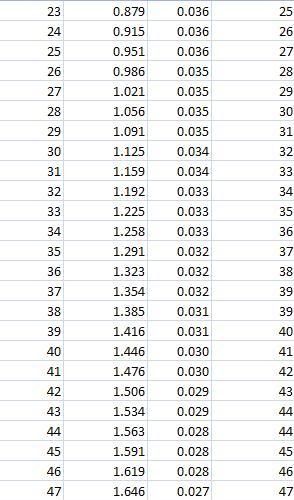
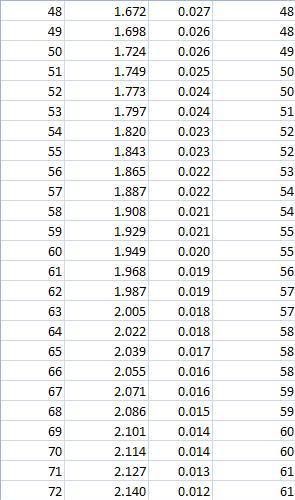
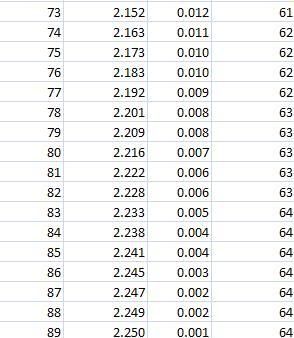
Btw, an interesting feature showed up by using 64ths as the aiming point fractions: The actual ANGLE is pretty close to the “64th number.” To show it more clearly, I also included the eight fractions as well. Of course, after 50-60 or so degrees, this doesn’t work anymore—as shown above: Fine cuts become VERY precise.

Below is a table with a selection of error ranges for shots. To calculate this I used an effective pocket size of two inches –for the CENTER of the object balls. This is a reasonable pocket size (about 4 ½" pocket), for most angle shots—even along the rail, if they’re slow enough. It’s not PERFECT, however—but a good estimate for the purposes of the discussion.
Please note that the figures in the table represent RANGES of aim point necessary to make the shot. They show how PRECISE your aim needs to be. To express how accurate your aim point has to be in the “plus or minus” manner, divide the figures by 2! So, even for the easiest shots of only a 1 foot shot, straight in, requires that you hit the OB with the CB over a range of about 3/8ths inch centered over the PERFECT spot.
Fine cut shots over four feet or so allow an aiming area only the size of TWO OR THREE HUMAN HAIRS in order to pocket the OB.
I also noted a “spot shot” made from near the head spot: The CB must hit the right spot on the OB within a range of 1/16th inch—i.e., +/- 1/32 inch. Not easy—and CERTAINLY no discussion of that kind of precision is mentioned in any way in any CTE method I’ve heard about
Formulas (if you’re interested):
Angles:
“=2*ATAN(1/12)*(180/PI())”
“=2*ATAN(1/24)*(180/PI())”
“=2*ATAN(1/36)*(180/PI())”
…etc.
0 deg cut: “=0.039*RC11”
30 deg cut: “=0.034*RC11”
45 deg cut: “=0.028*RC11”
60 deg cut: “=0.02*RC11”
80 deg cut: “=0.007*RC11”
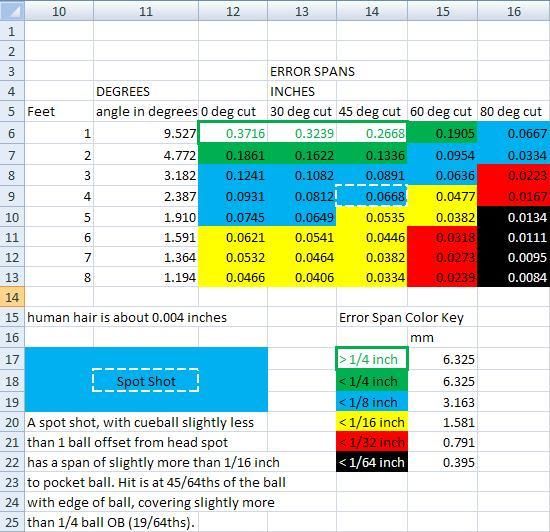
A recent thread has opened more discussion about it, and one post pointed further to a discussion about the error range in shot-making
I was surprised to see in that last post the claim that a fine cut shot could have an error range of only about a TENTH OF A MILLIMETER! Personally, I’m a little reluctant to just take people’s word for such things—and I had always intended to someday have a look at just this issue myself—so I thought I would figure out this information myself and see what it looked like. Below is the data I worked out. FIRST, please note, the info below says NOTHING about the need to adjust for throw or English—but those issues change only the aiming POINT, not the error range in aiming and making a shot.
To figure out how to calculate these I drew the diagram below, and quickly realized it was simple: I only needed to calculate the distance of point “a” from the origin—for balls of 2.25 inches in diameter.

The first bit of info is from Excel. The columns are:
1) The angle (in degrees) off the straight line down which the CB is shot. So, for example, a “1” is one degree off from a straight-in shot. An “89” is the finest cut shot.
2) Distance of CB edge (at equator) from OB edge (at equator). For example, to shoot the OB 1 degree to the left (from the straight line path of the CB), align the CB so that it’s left edge is 0.039 inches to the right of the OB edge. (Note: There is some rounding error in the figures, to make them easier to look at).
3) This difference between the measurement for this angle, and the preceding angle. This figure shows the difference in aim needed to change ONE DEGREE of angle, AT the angle being shot at. Note that this changes depending on the thickness of the cut.
4) Just for fun, I noted in this column how many “64ths of the OB” the aim point (col 2) would be at. If you’re going to use an edge aiming system, obviously you can’t estimate to aim “1.354 inches” from the OB edge. You have to have some method for estimating. It seems to me that the only reasonable way would be to divide the OB into fractions, and to aim at a certain fraction. The FINEST possible fraction system I could imagine would be practical would be into 64ths of the OB—making each fraction about 1/28th of an inch (2.25"/64).
If you want to try these calculations yourself, here are the Excel formulas for each column:
2 (aim): “=2.25*COS(RADIANS(90-RC[-1]))”
3 (Diff): “=RC[-1]-R[-1]C[-1]”
4 (sixty-fourths): “=ROUND(RC[-2]/(2.25/64),0)”
The main thing to note about these columns is toward the bottom of the last column: As cuts get thinner and thinner, more “1 degree angles” are included in each 64th fraction of the object ball.




Btw, an interesting feature showed up by using 64ths as the aiming point fractions: The actual ANGLE is pretty close to the “64th number.” To show it more clearly, I also included the eight fractions as well. Of course, after 50-60 or so degrees, this doesn’t work anymore—as shown above: Fine cuts become VERY precise.

Below is a table with a selection of error ranges for shots. To calculate this I used an effective pocket size of two inches –for the CENTER of the object balls. This is a reasonable pocket size (about 4 ½" pocket), for most angle shots—even along the rail, if they’re slow enough. It’s not PERFECT, however—but a good estimate for the purposes of the discussion.
Please note that the figures in the table represent RANGES of aim point necessary to make the shot. They show how PRECISE your aim needs to be. To express how accurate your aim point has to be in the “plus or minus” manner, divide the figures by 2! So, even for the easiest shots of only a 1 foot shot, straight in, requires that you hit the OB with the CB over a range of about 3/8ths inch centered over the PERFECT spot.
Fine cut shots over four feet or so allow an aiming area only the size of TWO OR THREE HUMAN HAIRS in order to pocket the OB.
I also noted a “spot shot” made from near the head spot: The CB must hit the right spot on the OB within a range of 1/16th inch—i.e., +/- 1/32 inch. Not easy—and CERTAINLY no discussion of that kind of precision is mentioned in any way in any CTE method I’ve heard about
Formulas (if you’re interested):
Angles:
“=2*ATAN(1/12)*(180/PI())”
“=2*ATAN(1/24)*(180/PI())”
“=2*ATAN(1/36)*(180/PI())”
…etc.
0 deg cut: “=0.039*RC11”
30 deg cut: “=0.034*RC11”
45 deg cut: “=0.028*RC11”
60 deg cut: “=0.02*RC11”
80 deg cut: “=0.007*RC11”

